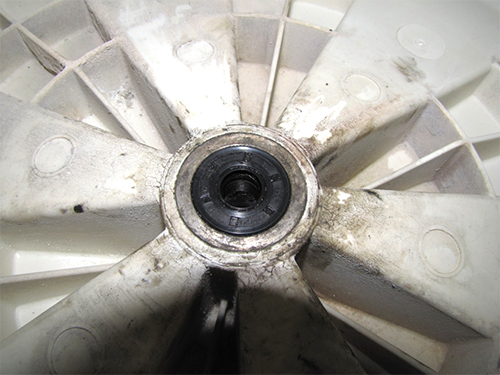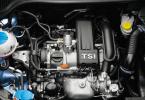The washing machine, like all household appliances, requires care and Maintenance. Many parts come into contact with water during operation, so they need high-quality protection from moisture penetration: for this purpose, the designers installed special cuffs that require regular lubrication. We will tell you how to lubricate or replace the oil seal for a washing machine at home.
Cuffs made of moisture resistant rubber are used in different techniques, so they have different shapes and sizes. The design is similar, only slightly different appearance. Varying quality and density rubbers: in some cases, seals are made of rubber on silicone, fluoroelastomer and other elastic materials.
These cuffs are made from special waterproof material with a metal insert, which is very brittle, but it is she who helps to keep the gland in the desired shape. When lubricating, you must be extremely careful not to break it.
Where are the seals
To get to them and carry out lubrication, it is necessary to disassemble the entire washing machine, with the exception of those models where a solid stainless metal tank is installed. At frontal type machines, the drum is mounted on a special bracket with a steel axle shaft in the middle: it is necessary to fix the drum housing on the bearing assembly.
Thanks to this design, the drum can rotate at different speeds, carrying out washing modes. Oil seals in the washing machine are installed in a special sleeve, together with which they protect the bearing assembly from water penetration.
Important! This part is very important - if it fails, the bearing will rust from moisture, it needs to be replaced urgently, and this is laborious work.
All dismantling operations can be performed independently if you are technically literate, know how to handle various tools and you have a lot of free time.
Lubrication Requirements
During maintenance, obligatory flushing and cleaning of the bearing housing and stuffing box, followed by filling them new grease. Used for cuffs various lubricants recommended by the manufacturer household appliances, but often these samples cost a lot, which is not affordable for many users.
Do not use automotive lubricants, choose more viscous ones in consistency: it must be remembered that water washes out the low-viscosity grease from the stuffing box and penetrates into the bearing assembly.
The main requirements for the quality of lubricants look like this:
- stable water resistance so that during the operation of the machine it is not washed out with water;
- in order not to corrode the rubber of the cuff, thereby reducing the life of the gland, it must be non-aggressive;
- good heat resistance- during operation, the bearings heat up, especially in the spin mode, when the drum rotates at maximum speed;
- constant consistency should not be changed so as not to leak from the place of application.
Poor-quality lubrication can spoil all your efforts and after a rather short time you will have to disassemble the machine again.

Lubricant selection
It is better to purchase lubricant in special stores where spare parts for washing machines are sold. Experts consider a silicone-based lubricant to be a good one - it has decent water resistance and meets all the necessary requirements. On the tube there are such parameters: water resistance, viscosity and maximum temperature of use.
When buying, pay attention to Liqui Moly Silicon Fett from German company, considered a leader in the production lubricants for various purposes. thick Silicone Grease resembles jelly, retains the elasticity of rubber and plastic up to +200 ° C, is produced in tubes of 100 g. It is expensive, but the quality justifies all the costs. Such a tube will be enough for you for the entire time of operation of the automatic machine.
It is worth paying attention to Anderol, it is manufactured by the company that produces cars Indesit. The packaging is in jars of 100 g or in disposable syringes containing two doses.
If you save on the purchase, you will lose money on subsequent repairs: low-quality grease for oil seals will quickly wash out of the bearing assembly, start extraneous noise or a creak in the washing machine.

The correct algorithm of actions
After the complete dismantling of the machine, proceed to stuffing box lubrication- apply it evenly over the entire area of the outer contour of the cuff. After that, insert the seal on workplace and gently lubricate its inside.
As you can see, the process is quite simple, but it must be done slowly and carefully so as not to damage the fragile metal insert. After finishing the lubrication, we proceed to the assembly of the washing machine.
If necessary urgent replacement oil seals due to damage or wear of their housing, a similar dismantling washing machine in the following order:
- filming top cover, remove the back and front panels;
- disconnect the wiring, pipes and fasteners from the tank to take it out;
- we disassemble the tank into two parts to open access to the bearing assembly.
You can do the disassembly yourself, but for the first time it’s better to invite the master with service center- he will perform all the manipulations quickly and with a guarantee. For those who are confident in their abilities, we attach to help next video where the master explains all the nuances correct installation stuffing box.
A washing machine is a device without which many people cannot imagine life for a long time. Usually, the owners of the car expect that the equipment will work for at least 8-10 years, but not everyone understands that the machine needs careful handling and timely service. The most important element machine is oil seal. The service life of washing equipment largely depends on it. In this article, we will try to figure out why you need a lubricant for the stuffing box of a washing machine and how to choose it.
What is an omentum?

The tightness that the sealing element provides is achieved due to the materials from which it was made. Usually it is rubber, silicone rubber, fluoroelastomer or something else. Inside it is a metal insert, thanks to which the part retains its shape. Despite the fact that the insert is made of metal, it is extremely fragile, so you need to be especially careful when using it.
During the operation of the device with inside The stuffing box constantly interacts with the shaft of the machine.
The lack of lubrication on the sealing part leads to an increase in friction, which results in rapid wear. Obviously, the tightness in this case will be broken, and the safety of the bearings is jeopardized. Lubrication for oil seals of washing machines will help to avoid the problem.
Where to get lubricant?
It is best to purchase it in specialized stores that sell equipment for the repair of household appliances. Often, washing machine manufacturers are also involved in the production of lubricants, claiming that this particular lubricant is suitable for a particular brand of machine. In cases where the cost of such a lubricant does not allow it to be purchased, you can buy an ordinary one, it will be no worse.
What you definitely shouldn't do is save money. Some owners of washing machines lubricate the part sealing the joint with ordinary vegetable oil, while others use grease for this purpose. In this case, the machine will not only not work better, with a high probability the economical owner will have to repair it in a few months.
Criteria for selection
In order for the oil seal to work for a long time and properly, it is necessary to correctly select the lubricant.
The following criteria must be taken into account:

- Water resistance. If it is not waterproof, then a solution of water and washing powder will wash it out of the sealing part in the shortest possible time.
- Non-aggressiveness. If the grease is too caustic due to some chemicals in the composition, it can damage both the sealing element itself and the metal axle shaft.
- Viscosity. Liquid composition will simply flow out and be washed out with water, there will not be much benefit from it.
- Resistant to high temperatures.During operation, the sealing part heats up, so the lubricant must tolerate temperatures of 180-200 ° C well.
Instruction
After the lubricant is selected and purchased, it must be used according to intended purpose. Lubrication is often done after.

First, for this you need to carefully remove the cover, and then remove the walls - front and back. Inside the washing machine is a tank that needs to be disassembled into two parts. After that, it will be possible to get to the bearing assembly and the bushing with the stuffing box.
Despite the fact that the washing machine is constantly in contact with water, there are parts in it that should not get wet. To a large extent, this applies to drum bearings, which wear out quickly when grease is washed out. The bearing is protected from water penetration by an oil seal - a hermetic seal.
Some users are wondering: do I need to lubricate the oil seal of the washing machine? Let's figure it out.
To begin with, consider the device and the principle of operation of the stuffing box. Not a single washer is complete without this detail.
This sealing rubber ring serves to protect the bearing at the joints from water. For high-quality sealing, the gland of the washing machine tank should sit as tightly as possible. That is why it is recommended to replace it at the same time as the bearings.

Passes through the central axis of the tank metal sleeve, which, when rotated, contributes to the wear of the stuffing box. To prevent this from happening, it is necessary to use a water-repellent grease for oil seals.
Some users use folk remedies such as oil or fat. Of course, this seems to be more cost-effective, since grease that meets all standards is expensive.
Dear users! Don't forget: saving on lubrication, you reduce the life of the oil seal. Subsequently, you will have to spend money on new parts and replace them.

Before replacing the oil seal, let's figure out which lubricant to choose.
Properties that a lubricant should have:
- Moisture repellent.
- Without aggressive chemical components. Otherwise, under their influence, machine parts will be destroyed.
- Resistant to temperature extremes.
- Viscosity - for long service life.
Experts recommend using LIQUI MOLY "Silicon-Fett" silicone water-repellent grease for oil seals. It is able to withstand temperatures from -40°C to +200°C. It is considered the most effective of all presented.

Other means are also popular. What else can lubricate the oil seal in the washing machine, read below.
Lubricant Italian made has a neutral chemical composition, water-repellent properties. Withstands temperatures up to +190°C. Perfectly retains its properties when heated. Suitable for all types of seals.

Ambligon - grease for oil seals from an Italian manufacturer. The product perfectly retains its properties when exposed to temperatures from -28 to +192°C. It is water repellent and chemically inert. It is packaged both in portions in syringes of 2 ml, and in packs of 100 g.

Multi-purpose grease resistant to water. Unlike non-professional products, it does not harden when heated. Able to withstand temperatures from -40°C to +120°C. Chemically and mechanically stable.

The agent has a moisture-repellent effect, reliably protecting components from corrosion. Maintains temperatures in the range from -40 °C to +120 °C. Compatible with other lubricants, does not compact in water, mechanically stable.
Homogeneous grease with multipurpose use.
Replacing the oil seal in a washing machine provides that the lubricant must withstand temperature extremes. CIATIM-221 is able to withstand from -60°С to +150°С. It is successfully used in friction units, does not lose its properties during boiling.
However, there are also disadvantages: the lubricant is hygroscopic, therefore, by absorbing moisture, it becomes denser and loses its properties. In addition, it cannot be used together with other means. Chemically inert.

Make your choice and purchase the right lubricant.
Now consider how to change the oil seal.
Let's see how you can get to the gland. Here are the step by step steps.
- After disconnecting the machine from the network and communications, drain the remaining water from drain filter. It is located under the front panel, behind a small hatch.

- Remove the two screws on the back to remove the top panel. Now unscrew the screws around the perimeter of the back panel, set it aside.

- Remove the drive belt from the drum. Having locked the pulley with the hammer handle, unscrew its central bolt and remove it from the tank.

- Disconnect any wiring that may be attached to the drum. It is usually secured with plastic ties, so use wire cutters.
- After disconnecting the motor wiring, unscrew the fixing bolts and pull the electric motor out of the housing. Also unfasten the wires from the heating element.

- Loosen the tank top counterweight bolts. Take it aside.
- Pull out the dispenser for detergents by pressing the center latch. Remove all screws holding the control panel. Opening the plastic latches, remove it and place it on top of the case.

- Loosen the clamp on the filling valve and disconnect it from the tank. Pull out the powder hopper with filling valve. To do this, unfasten the wires from the valve and unscrew the fastening bolts from behind.
- Remove the pressure switch hose, which is usually attached to the tank.
- Open the hatch door by bending the sealing rubber, remove the outer clamp. Tuck the cuff inside the tank. Unscrew the screws of the UBL lock by running your hand behind the SMA body, pull out the lock and unfasten the wiring.


- Unscrew the screws around the perimeter of the front panel, pull it up and set it aside.
- Remove the counterweights from the tank by unscrewing the bolts.
- After unscrewing the shock absorbers, remove the tank from the hooks and pull it out.
You've done a good job of dismantling the tank. Now let's figure out how to properly get and put the oil seal in the washing machine.


Before properly installing the oil seal, apply grease. Start lubricating the outer surface with a thin layer. After installing the seal in place, use a syringe to apply lubricant to the inner surface.
Like most household appliances, the work of the washing machine is aimed at facilitating human labor and performing everyday tasks. The device is powered by electricity and uses water. However, some parts necessary for the quality performance of the specified operations, in principle, should not come into contact with moisture. In order to prevent water from entering some parts of the washing machine and it lasts for a long time, special devices were designed - seals and cuffs.
Like other parts of the apparatus, they require proper care. Washing machine oil seals increase bearing life by preventing water and moisture from entering bearings. Why is it needed, how and when should it be lubricated?
What is an omentum?
It's tight technical material, located at the junctions of parts. It is he who prevents water from entering the technical departments and protects internal structure cars. In fact, not a single model of a washing machine can do without it, regardless of the manufacturer. The only difference that can be is the shape and size of the seal.

The specific properties and characteristics of the device directly depend on what material is used to make the gland. As a rule, they are made of silicone rubber or rubber. In the manufacturing process, a special metal insert is most often used, thanks to which the product retains the desired shape in the future and does not lend itself to deformation.
If we talk about the front ones, then in them the drum is mounted on a bracket with several special paws. A semi-axis is mounted nearby, which helps to fix the entire structure. In addition, it retains its mobility, due to which the drum begins to spin during operation. The seals are initially located on the sleeve. In tandem, they do not allow leaks. Provided complete security for other mechanisms. In the absence of any damage, the entire structure, including the bearings, is located, as if in a waterproof valve. If moisture gets on the bearings, then after a while they begin to rust, quickly stop doing their job.

Why is it necessary to lubricate the oil seal in time?
During operation, the shaft is in constant contact with inner surface this detail. Grease for oil seals for washing machines slows down the wear process of parts, ensuring free sliding. If the composition to reduce friction is neglected, the part sealing the joint will dry out over time and begin to let water through. This will lead to forced premature replacement of both the seal and bearings.
What kind of lubricant to use for the oil seal of the washing machine?
After replacement, the sealing device needs to be processed. Perfect option - waterproof lubricant for seals of washing machines. It is purchased in specialized stores that sell components for the repair of household appliances. In addition to water resistance, grease for oil seals for washing machines should have the following characteristics:
- Should not contain chemicals that can corrode rubber or soften it (as a rule, sealing parts are made from this material). A lubricant that is not suitable in its composition will not fulfill the functions assigned to it, but will only reduce the life of the stuffing box.
- Increased heat resistance. The specificity of the gland is such that during the operation of the washing machine it comes into contact with the shaft, in the process of friction and impact hot water the temperature of the parts rises. Therefore, the composition, which will soften the slip, must withstand the increase in temperatures. Quality lubricant for seals for washing machines can withstand temperatures up to 180 - 200 degrees.
- Thick composition. This important indicator good lubrication. Because during operation, the liquid solution will simply flow out.

If the owner of household appliances repairs with my own hands, and he had a question about which lubricant for the stuffing box of a washing machine is better, then you need to choose it according to the above criteria, and not according to the manufacturer. In any case, in any normal specialized store, sellers will advise desired composition, it is only necessary to explain its purpose.
Lubricant for the stuffing box of a washing machine: what to replace?
by the most good option will use those substances that have been recommended by the manufacturer of the washing machine. Many manufacturers produce branded lubricants, which, according to them, are suitable for a particular model of household appliances. But in fact, these are standard compounds that are suitable for any gland. Unfortunately, not everyone can afford even such lubricants, since this pleasure is not cheap.
As alternative good options, you can choose the following types of lubricants intended for machine maintenance:
- "Litol-24".
- "Ciatim-221".
- Azmol-Alumina.
- Ambligon.
Of course, there are many such options, but the above compounds have already been tested more than once on the most various models washing machines and showed good results in the process of use.
Is it worth replacing?
According to the masters, any alternative contributes to the softening of the part, which shortens its life. After a couple of years, the replacement will have to be done again. That's why the best option today there are those lubricants that are recommended by manufacturers of washing machines.

Conclusion
An oil seal in a washing machine is a part that seals and seals the connection, which has an important purpose. Thanks to him, the bearings are protected from moisture, prolonging their service life, and the normal operation of the washing machine. But in order for them to perform the functions assigned to them, they must be lubricated with special compounds that reduce friction and increase the service life of parts.
Today, automatic washing machines have become the most common things. They, like many other household appliances, are designed to take on some of the household tasks and make a person's life more comfortable and enjoyable. The design of the machines allows them to perform their duties efficiently. They run on electricity, use water and have some parts that should not come into contact with moisture.
The combination of these features of the functioning of the machine obliged their designers to create a system that allows you to combine all these things and at the same time maintain safe operation and the ability to long-term operation household appliances. Part of the tasks associated with protection against water entering unwanted places was taken over by various cuffs and seals for washing machines.
Description of the stuffing box
The seal is special material, whose task is to seal various joints and prevent water leakage.
It is used in all types of automatic washing machines. However, in different models he may have different shape and size. Oil seals used in washing machines may have some differences from oil seals used in other types of household appliances.
Their properties and characteristics depend, among other things, on the qualities of the rubber material from which they are made. In addition to rubber, they are made from silicone rubber, fluoroelastomer and other materials.
In the manufacture of all options for oil seals for a washing machine, a special metal insert is used. It plays the role of reinforcement and helps to maintain the correct shape. This insert can be quite brittle, so care must be taken during the replacement process so as not to damage it.
Oil seal in the design of the washing machine
 Let's analyze the issue of the location of the gland in the frontal washing machines. The drum in these machines is fixed on the bracket. The bracket has several paws. Usually 3-4 pcs. In the middle of it is a steel semi-axle. It is needed in order to secure the drum to the bearing assembly. This fixation option allows the drum to rotate. That is, to have mobility. The axle shaft makes the motor turn.
Let's analyze the issue of the location of the gland in the frontal washing machines. The drum in these machines is fixed on the bracket. The bracket has several paws. Usually 3-4 pcs. In the middle of it is a steel semi-axle. It is needed in order to secure the drum to the bearing assembly. This fixation option allows the drum to rotate. That is, to have mobility. The axle shaft makes the motor turn.
Seals for washing machines are not fixed to the shaft, but to a special sleeve. And paired with it ensures the normal operation of the washing machine and protection against water leakage. They provide watertightness and protect the bearings and the entire assembly from moisture penetration. If moisture gets on the bearings, then pretty soon they will rust and become unusable.
The seal is a very important part of the machine. After all, if it is damaged, then it will be necessary to change not only the oil seal, but also the bearings. And replacing bearings requires almost complete disassembly of the washing machine. This is a very labor intensive task. And if you call the master, then the repair will not be the cheapest. And if you take it yourself, then it will require a lot of time and effort.
Instructions for self replacement bearings you can find below.
Replacement
In fact, to replace the seals, you need to do the same thing as to replace the bearings. That is, almost completely disassemble the machine. First you will need to remove the cover (top of the case), then remove the front and back walls. Then get to the tank, remove it. Disassemble the tank into two halves. And after that you can get to the bearing assembly. This is how the seal and bearings are located. We will not describe the entire replacement procedure in detail, since it is already described in the article on replacing bearings, which is on our website.
In order for you to understand how much work you have to do, we suggest that you familiarize yourself with the video recording similar repairs washing machine. You can also replace both the seals for washing machines and the bearings yourself, simply by doing the same thing that the master does in the video. This video was recorded in English, but in order to repeat all the steps or just estimate the amount of work, you do not need a translation. Watch the video:
Oil seal lubrication
When replacing a bearing and an oil seal, it (the oil seal) must be filled with grease. The best option there will be the use of those lubricants that are recommended by the manufacturer of the machine. However, such a lubricant may not be cheap. Some craftsmen use automotive and other types of lubricants. Such as:
- Litol-24m,
- CIATIM-221,
- AZMOL-Alumina,
- AMBLIGON,
- and etc.
It is believed that most types of lubricant are not suitable for this purpose. Since they soften the stuffing box and it can fail again in a year or two. Therefore, if you want to be sure that the machine will work properly and for a long time, it is better to use lubricants recommended by manufacturers or others, but tested by you in practice.



